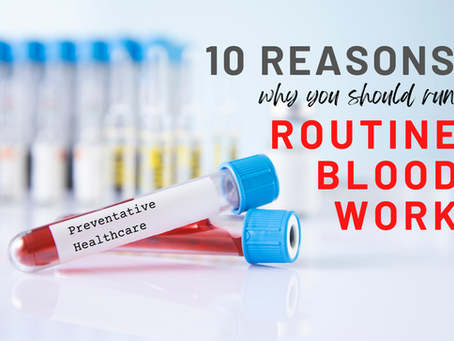It’s rare that I work with a new client without having a recent blood work panel from within the last 30 days. This seems strange to some. What does blood work have to do with nutrition?
Everything!
There are incredible insights to be gained from blood work if we know where to look and what to look for.
Blood work is the basis that allows functional medicine to be so effective. While I’m not a doctor and I don’t diagnose or treat anything that may appear in someone’s labs, what I aim to find are preliminary patterns that your doctor likely isn’t looking for; patterns that could eventually lead to health diagnoses or diseases if left unchecked.
These patterns often can be addressed with simple yet remarkably effective dietary and lifestyle modifications and, sometimes, supplementation.
This is the ultimate preventative approach to health. When you know what’s going on internally, you’re able to stay in charge of your health and well-being.
The patterns I’ll be discussing are often still well within the standard ranges that your doctor uses to make diagnoses or determine the cause of symptoms. They also typically do not manifest overt symptoms early on, so it’s all too easy to overlook them.
Problems arise when mild deficits or imbalances are left unresolved for long periods of time. Thus, by staying in the know about your internal state, you can stay far ahead of illness and disease – this is what healthcare should be.
Waiting for overt symptoms or diseases to appear before intervening is sickcare, not healthcare.
Let’s dive into the top reasons to have blood work done on (at least) a yearly, or (ideally) bi-yearly basis. I’ve learned these both from my education in functional medicine and from the experience of reviewing hundreds of lab results.
If you’re thinking “this sounds expensive” or “this must require advance testing”, I’m happy to inform you that we can gain incredibly insightful infromation from just the basics.
The basics are the tests your doctor runs during your annual physical like a CBC with differentials, lipids, and a CMP. You can also request additional markers like an iron panel, uric acid, hs-CRP vitamin D, reproductive hormones, and thyroid hormones.
We’ll review what each of these tests can tell you about your health. In the last section of this article, you’ll find tips on how to request them from your doctor or how to order the basic labs yourself for less than $100.
1. A Complete Blood Cell Count (CBC) can Inform B Vitamin & Micronutrient Status & Breathing Issues
A CBC looks at different parameters within your red blood cells (RBCs) incuding their amount, weight, size distribution, width, volume, and their capacity to carry oxygen throughout your body with a molecule called hemoglobin.
Your body is constantly making RBCs and requires specific nutrients to make them. Specific patterns in the shape, size, and weight of these cells can tell you if you’re getting enough B vitamins in your diet or from supplements. Specifically, B12, B6, and folate as these three vitamins are very much involved in regulating the growth of RBCs.
We can also infer about other vitamin and mineral statuses like B1, B2, lipoic acid, iron (see #5 for must-know info on iron), and cofactors like Co-enzyme A.
Potential issues related to chronic B vitamin insufficiency:
Vitamin deficiency is rare in developed nations, so it’s not likely that individuals will present with issues like scurvy, Wernecke’s encephalopathy, or pellagra these days. However, insufficiencies in B vitamins can result in less-than-optimal health and mild symptoms such as the following:
- Low energy production
- Fatigue
- Brain fog/cognitive impairment
- Inflammation (more specifically related to elevated homocysteine levels)
- Muscle weakness
- Neurological symptoms
B vitamins act as cofactors in metabolic reactions – they are essential cogs in the wheel that drive certain chemical reactions forward. Without sufficient quantities, things can get backed up. Some people may require higher B vitamin intake due to genetics and some may not be getting enough in their diet; for many, it’s a combination of both.
Having your CBC reviewed with a functional medicine lens can help ensure that your body has the essential vitamins, minerals, and cofactors it needs. Addressing imbalances here can take you from feeling good to feeling great.
CBC for Breathe Efficiency and Snoring
Because RBCs are how your body delivers vital oxygen to every cell and tissue, tight regulation is kept on this process. Some patterns in a CBC along with carbon dioxide levels (CO2 on a CMP test) can inform if someone is breathing too shallow, too often, or if they’re snoring at night.
Even in the absence of sleep apnea, snoring can cause major metabolic disruptions and health issues. Additionally, light and shallow breathing can stimulate your body’s stress response and prevent you from efficiently activating your parasympathetic nervous system (rest, digest, repair system).
I’ve seen simple lifestyle modifications and deep breathing practices make a world of a difference to these markers and to patients’ overall well-being.
2. CBC Differentials (White Blood Cells) inform Inflammation Status & Potentially Type of Infection(s).
Differentials tell you about the numbers and percentages of the different types of white blood cells (WBCs). They are often done along with a CBC but it must be specified on the lab request. I always request differentials as they offer incredible insights into the potential source of inflammation.
This is very important as natural support for viral, bacterial, fungal, parasitic, and systemic inflammation comes in many different forms. When we know the source, we’re better equipt to correctly address the imbalance.
For example, if inflammation is coming from a viral infection, it would be much more effective to use natural support like quercetin, echinacea, elderberry, and oregano oil rather than antiparasitic herbs like fenugreek, wormwood, black walnut hull, and caprylic acid.
- Potential issues related to different types of low-grade chronic infections:
- Low-grade viral activity (herpes, Epstein bar, long COVID, hepatitis, HIV, etc.) – systemic inflammation, mitochondrial imbalances/impaired energy production, recurrent illness, chronic fatigue, brain fog/cognitive impairments.
- Bacterial-driven inflammation – gastrointestinal issues/IBS/IBD, recurrent illnesses, recurrent respiratory tract infections, genitourinary infections, brain fog, upstream to several other specific health issues.
- Fungal infections – gastrointestinal issues, candida, recurrent yeast infections, brain fog, chronic fatigue.
- Parasitic inflammation – gastrointestinal issues, diarrhea, chronic allergies.
- Systemic Inflammation – chronic fatigue, CVD risk, brain fog, low energy production, potential toxin/heavy metal exposure.
3. Electrolyte Status on Energy Efficiency, Kidney Health & Hydration, Nutrition Status, & Stress Levels
Comprehensive metabolic panels (CMP) include kidney markers and electrolytes. Your kidneys keep a close reign on fluid levels in your body. Electrolytes along with blood urea nitrogen (BUN) and creatinine are a great indicator of kidney function and hydration status. BUN is also a good indicator of your protein intake status.
Electrolytes (sodium, potassium, chloride, calcium, and bicarbonate (carbon dioxide/CO2) are essential cofactors involved in thousands of reactions in the body. Your body keeps these levels very tightly regulated as imbalances can lead to a myriad of issues.
It’s not very common to see these minerals outside of conventional ranges except in extreme cases (in which case, you should see a doctor ASAP), but patterns outside of optimal ranges can inform nutrition status and help dial in your dietary habits to better support optimal health.
Electrolytes are also informative for certain lifestyle factors. If these numbers are lower than optimal, this could indicate that one is potentially overhydrated or losing them through sweat. Putting practices in place to offset can dramatically improve performance, cognition, stamina, and endurance – especially important for athletes.
We can also assess adrenal function (to a certain degree) from patterns that appear in sodium and potassium. If you’re experiencing too much emotional or physical stress (from insufficient rest/recovery or overexertion), this pattern can inform specific lifestyle interventions to improve well-being and support balance. This is very useful in athletes, over-achievers, and type A personalities.
Potential issues related to imbalanced electrolytes & impaired hydration status:
- Lightheadedness and/or dizziness
- Fatigue
- Muscle cramping
- Decreased endurance capacity
- Muscle weakness
- Neurological imbalances
- Brain fog/cognitive issues
4. Liver Enzymes as Markers for Detoxification Capacity & Metabolic Function
A CMP also includes a plethora of liver markers. Conventional ranges are useful for indicating extreme nutritional deficiencies, but not so much for mild insufficiencies.
Where these markers are most helpful in the eyes of functional medicine is understanding the potential toxic load on the body, detox capacity, and certain metabolic functions.
Your liver sorts through nearly every item that enters your body including food, medications, and environmental toxins. It also removes several chemicals that your body produces endogenously and makes several of its own molecules and proteins.
It has 3 phases of detoxification and each requires a certain number of compounds to activate them. These compounds come in the form of micronutrients and amino acids from protein, thus having the previously-discussed labs is essential for assessing nutrient status to support healthy liver function.
When the liver is congested or backed up, it is not as efficient at detoxing harmful chemicals and compounds from the body. This can lead to oxidative stress (see #9) and systemic inflammation (see #2 and #6). The liver makes certain inflammatory compounds in response to stress which can lead to all sorts of metabolic imbalances.
I’m in support of doing a liver cleanse at least once a year for those following a healthy diet and lifestyle and up to 4 times a year (or over a longer period of time) for those who follow a standard American diet and are not active.
A juice cleanse is not a liver cleanse – this can lead to more issues due to insufficient protein intake. I typically recommend Liver IQ for 30 days as a great detox/metabolic reset.
If you keep your liver healthy, you subsequently support healthy hormone balance, nutrient absorption and utilization, healthier blood lipid levels, and reduced toxic stress.
Potential issues related to mild liver imbalances:
- Chronic inflammation – fatigue, brain fog, shortness of breath, generally feeling ‘unwell’.
- Toxic load/toxic stress – Heavy metal toxicity, cognitive impairment, memory loss, electrolyte imbalances (see #3), chronic inflammation.
- Metabolic imbalances – dyslipidemia, blood sugar dysregulation, fatty liver, cardiovascular risks, impaired nutrient absorption.
5. Iron Status – Beyond Anemia: You Should Probably Stop Taking an Iron Supplement
We depend on iron in our red blood cells to carry oxygen throughout the body. One molecule of hemoglobin holds 4 iron atoms. There are over 300 million hemoglobin molecules in 1 single red blood cell. Iron is just as vital for our survival as oxygen. Without it, we have no oxygen.
So it probably sounds crazy that I just said you should stop taking an iron supplement, right? The explanation for this is grounded in solid biochemistry and nutrition science but far too few providers look beyond iron levels – if they look at iron at all. Traditional thinking is this:
- draw labs.
- read iron level.
- if low: give iron supplement.
Seems simple enough. If something is low doesn’t that mean you need more? Not always. There are some cases when someone’s iron status is truly low (though this is mostly present in vegans/vegetarians/pescatarians who do not eat any fortified grains or cereals). But more often than not, what presents as anemia in labs is not due to too little iron, it’s due to the body not being able to use the iron that’s there.
This is why we need to look at more than just single markers to determine what the body actually needs. Patterns in multiple markers including total iron binding capacity, iron saturation, and CBC markers need to be assessed to accurately inform what is going on. If the body can’t use iron, taking more iron is not going to solve the imbalance.
We get back to the importance of vitamins and minerals for effective iron utilization. If you don’t have enough copper and magnesium, you can’t use iron correctly. If you don’t have enough vitamins A, Bs, and C, you can’t use copper and magnesium efficiently.
This is why it’s SO important to understand the root cause of imbalances. We have to look beyond the imbalance itself. Most foods are fortified with iron, and meat (particularly red meat) is high in iron. Even someone following a standard American diet is getting plenty of iron in their diet – what they’re not getting is adequate magnesium, copper, retinol (vitamin A), and B vitamins.
Even the healthiest eater likely isn’t getting these essential nutrients from food anymore. Modern agricultural processes have stripped the soil of these vitamins and minerals. Organ meat like liver is a rich source, but let’s be honest – we’re not eating organ meat these days like our ancestors used to.
Additionally, too much iron is very damaging to health. It acts as a free radical, damaging tissue and causing oxidative stress. And most iron found in multivitamins is not in a bioavailable form which can worsen oxidative stress.
If you did nothing else related to functional medicine, I would highly encourage you to at least have your iron status assessed by someone who understands this intricate interplay of minerals given how vital this one molecule is to your health.
Potential issues related to inefficient iron utilization and iron overload:
- Shortness of breath
- Lightheadedness
- Dizziness
- Fatigue
- Thick blood
- Muscle Cramps
- Brain fog
- Systemic/chronic inflammation
- Low vitamin D levels
6. hs-CRP, Ferritin, & White Blood Cells for Informing Inflammation Levels
We’ve covered WBCs (see #2) for assessing the potential source of inflammation. The challenge with assessing only WBCs in isolation is that there can often be multiple sources of inflammation in the body.
Sometimes, we may not find any particularly helpful patterns in the WBCs alone, but we can extrapolate information from additional helpful markers.
hs-CRP stands for high-sensitivity C-reactive protein and it’s the universal marker for the level of inflammation in the body. Conventional ranges are not established for all labs, but anything over 1.0 should be addressed with anti-inflammatory protocols. This is a very sensitive marker for heart disease and it can have many causes – including and excluding those found in WBC patterns.
Ferritin is another excellent marker of inflammation. It is a storage molecule for iron that’s made primarily in liver cells. This molecule is supposed to be inside of cells, not in the blood, when levels are elevated, this means that tissue damage is happening somewhere, this is called necrosis.
Oxidative stress can cause non-specific inflammation and can be caused by insulin/blood sugar imbalances, nutritional deficiencies/insufficiencies, mitochondrial issues, and metabolic imbalances. We can assess CBC markers, iron status, liver status, and antioxidant capacity (see #9) for a more definitive direction on the cause of inflammation.
See #2 and #4 for potential issues related to inflammation levels.
7. Lipids & Triglycerides can Often Inform More about Carb Intake than Fat
First things first. Dietary Cholesterol does not cause your blood cholesterol levels to rise. When you eat cholesterol from foods, you break down the cholesterol molecule during digestion. So please, eat eggs for breakfast and get that protein in early in the day!
Saturated fat, on the other hand, is associated with an increase in blood cholesterol levels, so if you have high cholesterol, it is worth being mindful of saturated fat intake (this includes full-fat dairy, cheese, butter, red meat, pork, coconut oil, and palm oil).
One thing that many people are unaware of though is that excessive carb intake will increase your blood cholesterol levels as well. This is mostly seen with highly-processed carbs. Fiber along with balanced carb intake will help to keep cholesterol levels balanced. Thus cholesterol serves as a very informative marker for dietary interventions.
Triglycerides are also associated with carb intake but in a more consequential manner. Excess highly processed carbs result in high spikes in insulin. High insulin levels preceded insulin resistance and type 2 diabetes. Elevated triglycerides are associated with insulin resistance.
Even if you’re not looking too deep into diabetes risk factors, or if your blood sugar and A1c are normal, triglycerides can inform whether or not an earlier intervention for diabetes prevention is warranted.
Potential issues to address related to elevated cholesterol levels:
- Reduce processed carb intake and increase fiber.
- Reduce saturated fat intake and increase healthy fats
- Assess dietary patterns and make adjustments towards healthier habits
- Incorporate healthful lifestyle interventions like exercise, forest bathing, and emotional stress.
8. Insulin: Identifying Risk for Diabetes Long Before Blood Sugar Levels are Affected
Fasting insulin is an additional marker that I want all of my clients to have run at least once early on and then every couple of years thereafter.
Insulin levels can tell you if you’re at risk for developing diabetes long before your blood sugar levels start to run a little higher than usual and before even insulin resistance appears.
There are several stages that must happen prior to the onset of type 2 diabetes.
- The first stage is called hyperinsulinemia where the body is making excessive amounts of insulin in order to keep blood sugar levels in check, but it’s keeping them in range nonetheless (at this phase, you will not catch early onset by looking at fasting blood sugar and A1c).
- After some time with chronic hyperinsulinemia, insulin resistance develops (at this phase you might see this in elevated triglycerides).
- When the body becomes insulin resistant, this is when blood sugar management goes awry, and fasting blood sugar levels climb above 90 mg/dL. At this point, the body is not responding to insulin like it’s supposed to and insulin levels are still very high.
- If left unchecked for too long, beta cells that make insulin begin to die and the body no longer makes adequate insulin to manage blood sugar on its own (this is when T2Ds are put on insulin injections).
Wouldn’t it be amazing to tackle this disease in the earliest stage, when it’s most reversible and easy to correct? That’s why I want to see fasting insulin levels. Don’t be discouraged if you already have high blood sugar or have been diagnosed with T2D, there’s still plenty you can do to begin restoring balance.
Resistance exercise is hands down the best thing to do to improve insulin sensitivity. I’ve written extensively on this several times before, everyone should be doing resistance exercises. Diabetes prevention or not, it’s essential!
Potential issues related to blood sugar and insulin dysregulation/early signs:
- Feeling excessively thirsty
- Fatigue/lethargy
- Feeling “shaky”, light-headed, racing heart rate, cold sweats, anxiety
- Reactive hypoglycemia and/or intense sugar cravings
- Oxidative stress
9. Bilirubin & Uric Acid for Oxidative Stress & Antioxidant Status
While bilirubin is on a CMP, uric acid is not so must be ordered separately. Bilirubin is often thought of in terms of assessing liver health status and is associated with jaundice, cholesterol, and gallbladder issues when outside of conventional ranges.
Uric acid is commonly thought of as causing gout. But there is much more to these two molecules. At tighter ranges, they can inform the body’s antioxidant status and if there’s oxidative stress. Both of these molecules also act as antioxidants themselves.
It’s expensive and not very accurate to test glutathione levels (our body’s most important and abundant antioxidant), so assessing these established and validated markers as surrogates for antioxidant activity and capacity can offer invaluable insights into health and disease prevention.
Potential issues related to oxidative stress:
- Fatigue/lethargy
- Nutritional insufficiencies
- Breathing imbalances/snoring
- Iron overload
- Cognitive impairments and brain fog
- Infection/inflammation
- Blood sugar imbalances
10. Hormones: Identifying Up-stream Issues, Genetics, Autoimmunity, & Determining if HRT is Right for You
I have a different take on hormones than many functional medicine practitioners. In my opinion, I think too many practitioners rush to hormone replacement therapy (HRT) without first addressing the true root cause.
Hormones are very important for overall health, well-being, and mood/emotional regulation. There are many times when HRT is an essential and life-changing intervention for some people. This is often the case when genetic variability or autoimmunity is the cause of hormone imbalances.
A more common reason for hormonal imbalances in many people is the upstream imbalances discussed in #1-9. Sleep disruptions, gut imbalance, nutritional deficiencies, stress, oxidative damage, and toxic overload can all impair hormone production and function.
I believe it’s imperative that we first address the root cause of the imbalance rather than immediately putting someone on HRT.
Your brain and organs are constantly assessing hormone levels. When levels are high, it shuts down hormone production – this is called negative feedback. When you give exogenous hormones, your body often stops making its own because levels stay elevated. This can sometimes weaken the cells that make such hormones.
This is why men who go on testosterone become infertile while on it and have to take specific brain-stimulating compounds to restart natural testosterone production after coming off of it.
I’ve seen several hormonal imbalances come back into range after addressing the upstream issues. So jumping straight to HR is not wise in my opinion.
In addition to addressing root-cause imbalances, it’s important to note that everyone is going to have different levels of hormones, and their receptors are going to have differing levels of sensitivity. I’ve seen too many people put on HRT when their numbers were considered “low” by functional medicine ranges despite having NO SYMPTOMS related to low hormone levels.
Please work with someone who understands these nuances and doesn’t just want you to go on HRT because it’s the current fad in functional medicine (you know by now my incessant cynicism towards dangerous health fads has to come out somewhere on each topic).
Now that we’ve gotten that important piece covered, let’s dive into the hormones worth keeping an eye on:
Vitamin D and thyroid stimulating hormone (TSH) are very commonly run along with basic panels. Your doctor should include these at your request. In the absence of thyroid symptoms or disease, I prefer to assess TSH prior to running a full thyroid panel (free and total T4/T3, thyroid antibodies, reverse T3, TBG, and T3 uptake). Both of these hormones are very informative when taken alongside the markers discussed above.
Vitamin D, like iron, also requires a knowledgeable eye to ensure supplementation is safe. It can appear low if an infection is present and if there are dormant microbes throughout the body. It should be assessed in conjunction with all other basic markers.
Reproductive hormones decrease with age and are very much essential to overall health and well-being. When someone presents with overt hormone symptoms, we’ll go ahead and run a full workup. It’s also good practice to rerun them at least once every 2-3 years to assess how they are changing with age. T
his can help to ensure there are no drastic fluctuations that may need addressing. It’s also useful for determining the appropriate time for women to start HRT as they progress into and through menopause. Reproductive hormones panels should include testosterone (free and total), estrogen (free and total), progesterone, LH, and FSH, SHBG, DHEA, and men should include DHT and PSA.
Running Labs Through Your Doctor & Insurance vs. Ordering them Online
Most doctors will run a CBC, lipids, and a CMP as part of your annual physical. Usually, they will include differentials (the white blood cells) with the CBC but some do not so it’s worth requesting them.
The additional markers can sometimes be a little more of a challenge to have your doctor order. More often than not, I’ve had clients request to do their labs through their doctor so that insurance can cover the cost only for them to come back with several important markers missing.
I can understand some of their reasoning. Many doctors are not cleared to treat areas outside of their scope of practice (i.e your PCP may not run hormones since they are not an endocrinologist or OBGYN and thus, they do not have the training and education to be able to address imbalances here).
When this happens, you can ask them for a referral. The benefit to this is that insurance may cover the labs, the downside is several doctor’s visits, potential deductible bills (doctor’s offices bill insurance companies WAY more than their cash-pay prices), and multiple blood draws – which can introduce variability when interpreting labs.
Another reason that doctors may not order certain markers is that they have to give a code to insurance to justify why they’re running the test. You should be able to request hs-CRP, TSH, and vitamin D with no pushback.
For an iron panel, you can explain that you’re feeling fatigued, low energy, shortness of breath, dizzy upon standing, experiencing weakness, and cold hands, so you want to make sure your iron levels are okay. For women, if you have a heavy menstrual cycle, this is a good reason for your doctor to check for anemia.
If you suspect that you have oxidative stress and you want to check uric acid, a family history of gout or pain in your big toes would give reason to order this test.
You can ask your PCP to run T3, T4, reproductive hormones, and insulin – it wouldn’t hurt to ask. Though my experience has been that they will not. Sometimes they will only refer you out to a doctor who can run them if something comes back abnormal on their standard labs – so beware of the challenges you may run into.
Another option is to see an interest. They can request all of these labs and also treat patients as a PCP.
My experience has been that it’s much easier to order labs yourself online. Here’s a basic yet comprehensive panel that you can order for less than $100 if you enter the code ULTALABORDAY at checkout (valid at the time of writing this article – reach out to me for a coupon code if this one’s expired).
If you’d like to go ahead and run a more comprehensive panel looking at insulin and other hormones, or if you have specific health concerns, reach out to me and we’ll put together a personalized panel that’s specific to your unique needs and health state.
Once you have your lab results, you can schedule an appointment for a functional medicine review of them to identify any of the patterns discussed above.
This is the most proactive and preventative approach you can take for your health. I strongly encourage everyone to have labs done at least yearly and to have them reviewed both by your doctor and someone like myself who’s trained in identifying preventative patterns discussed in this article.
Remember, several of these patterns can appear when markers are still “within” conventional ranges – unless your doctor is trained in FM, they likely will not spot them early enough. A functional medicine review can go a long way for your health.














